MMRU is an integrated unit within the Institute for the Oceans and Fisheries that works with other departments and institutions, combining specialties in a coordinated effort to provide independent research and advice on matters related to marine mammals.
The research program consists of four components:
FIELD STUDIES

Field Studies
Contrasting declining populations of seals, sea lions and whales with healthy populations to save them from extinction.
CAPTIVE STUDIES

Captive studies on marine mammals
to enable the development and testing of new techniques and technologies for studying marine mammals in the wild; and to provide information that field studies cannot, such as physiological data, nutritional requirements and how they use energy derived from food;
DEVELOPING NEW TECHNIQUES

Developing new measurement techniques
Developing new ways
to process biological samples, analyze data, and collect data remotely from marine mammals.
INTERDISCIPLINARY STUDIES

INTERDISCIPLINARY STUDIES
Drawing on experts from different fields of study to analyze historic data sets, construct mathematical models, and undertake novel laboratory analyses
Some specific questions being explored are:
- what are the abundance and population trends of marine mammals?
- what criteria can be used to determine population health?
- how much prey is consumed?
- what is the resource base and how is it affected by marine mammals?
- where do marine mammals occur and what determines their distribution and habitat needs?
- how do marine mammals navigate through the open ocean?
